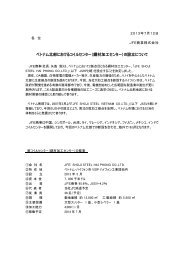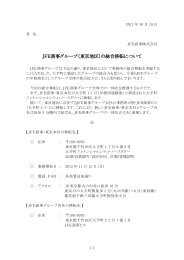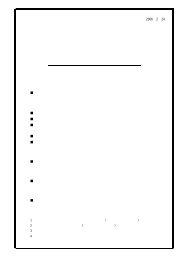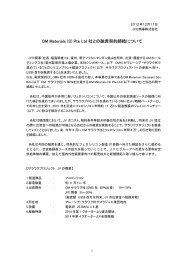2. SUMMARY OF SIGNIFICANT ACCOUNTING POLICIES (continued)c. Cash and Cash EquivalentsFor the purposes of the Cash Flow Statements, cash and cash equivalents comprise cash on hand, deposits with bankswithdrawable on demand, net of overdrafts, and all highly liquid short-term investments which are readily convertible to cashsubject to an insignificant risk of any changes in their value and which were purchased with an original maturity of threemonths or less.d. Investments in SecuritiesInvestments in securities are mainly stated at cost as determined by the moving-average method. Effective April 1, 2000, theCompany and its consolidated subsidiaries adopted a new accounting standard for financial instruments. The effect of theadoption of this new standard was to increase loss before income taxes and minority interests by ¥2,508 million for the yearended March 31, 2001.Under the new standard, trading securities are carried at fair value, and gain and loss, both realized and unrealized, arecharged to income. Held-to-maturity debt securities are carried at amortized cost. Marketable securities classified as othersecurities are carried at fair value with changes in unrealized gain or loss, net of the applicable income taxes, reported as aseparate component of shareholders’ equity. Non-marketable securities classified as other securities are carried at cost.As allowed under the new standard, the Company and its consolidated subsidiaries have postponed recording marketablesecurities classified as other securities at fair value until the year ending March 31, <strong>2002</strong>. The effect on the consolidatedbalance sheet at March 31, <strong>2002</strong> of adopting this new standard was to increase net unrealized loss by ¥1,623 million($12,180 thousand), deferred tax assets by ¥2 million ($15 thousand), deferred tax liabilities by ¥89 million ($668 thousand),and minority interests by ¥6 million ($45 thousand) for the year ended March 31, <strong>2002</strong>.e. InventoriesInventories are mainly stated at cost determined by the moving average method.f. DerivativesDerivative financial instruments are stated at fair value.g. Property and EquipmentProperty and equipment are carried at cost, except that one affiliate revalued its land pursuant to laws on land revaluation.Depreciation is provided by the declining-balance method over the estimated useful lives of the assets except for those heldby certain subsidiaries which apply the straight-line method. The straight-line method is applied to buildings acquiredsubsequent to April 1, 1998.h. Allowance for Doubtful ReceivablesUp to the year ended March 31, 2000, the Company and its domestic consolidated subsidiaries provided an allowance fordoubtful receivables principally at the estimated aggregate amount of probable bad debts plus the maximum amount permittedto be charged to income under the Corporation Tax Law of Japan.Effective April 1, 2000, the Company and its domestic consolidated subsidiaries adopted a new accounting standard for financialinstruments. Under this new accounting standard, the Company and its domestic consolidated subsidiaries have provided anallowance for doubtful receivables at the estimated aggregate amount of probable bad debts plus an amount calculated basedon their historical experience of bad debts. The effect of the adoption of this standard for financial instruments is disclosed ind. “Investments in Securities” on an aggregate basis.The foreign consolidated subsidiaries provide an allowance for doubtful receivables at the estimated aggregate amount ofprobable bad debts.37
2. SUMMARY OF SIGNIFICANT ACCOUNTING POLICIES (continued)i. Accrued Retirement BenefitsEffective April 1, 2000, the Company and its domestic subsidiaries adopted a new accounting standard for retirement benefits.In accordance with the new standard, accrued retirement benefits are provided based on the amount of projected benefitobligation reduced by pension plan assets at fair value at the end of the annual period.j. LeasesThe Companies lease certain equipment and fixtures under non-cancelable lease agreements referred to finance leases.Finance leases other than those which transfer the ownership of the leased property to the lessees are accounted for asoperating leases.k. Hedge AccountingThe Companies apply deferred hedge accounting to interest rate swaps to manage interest rate fluctuation risks based onthe Company's internal management rule.l. Interest CostThe Company capitalizes interest cost as a component of the acquisition costs of projects and land under development heldfor sale, if estimated acquisition costs are ¥500 million or more and development periods exceed one year.m. Income TaxesThe Companies recognize deferred income taxes arising from temporary differences between the tax basis of assets andliabilities and their reported amounts in the financial statements.n. Unrealized holding gains on landUnder the law on land revaluation and revised law on land revaluation, an affiliate company, which is accounted for by the equitymethod revaluated land held for its own use during the year ended March 31, <strong>2002</strong>. The unrealized gain on land holdings, netof the applicable income taxes, is reported as a separate component of shareholders’ equity.o. Amounts Per ShareThe computation of basic net loss per share is based on the weighted average number of shares of common stock outstandingduring each year. The average number of shares used in the computation was 134,330 and 131,111 thousands for the yearsended March 31, <strong>2002</strong> and 2001, respectively.38


![Annual Report 2002 [PDF/1.6MB]](https://img.yumpu.com/44293603/37/500x640/annual-report-2002-pdf-16mb.jpg)











![Annual Report 2004 [PDF/1.1MB]](https://img.yumpu.com/28997981/1/190x247/annual-report-2004-pdf-11mb.jpg?quality=85)